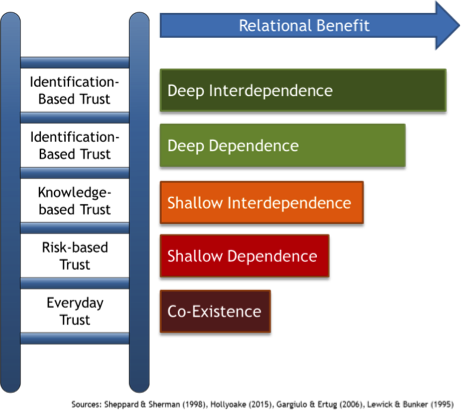Trust Ladder Part 4: Trust, Interdependence & Equitability
What are the common problems facing Customer Management organisations seeking to move up the Trust Ladder and how do they tackle them to improve performance?
Our last blog focuses on ways trust, interdependence and equitability can overcome problems caused by competing approaches to Customer Management which cause inconsistencies and undermine an organisation’s ability to develop trust.  It often happens as a result of business unit integrations, mergers/acquisitions, or where suppliers have a number of account managers/sales people visiting the same customer for different categories. At worst, disparities and differences in thinking and approaches create a gaping hole for customers to exploit. At best, they lead to internal fuzziness/loss of potential value and volume. Good business practice, whether inside an organisation or between organisations, rests on three vital underpinning drivers:
It often happens as a result of business unit integrations, mergers/acquisitions, or where suppliers have a number of account managers/sales people visiting the same customer for different categories. At worst, disparities and differences in thinking and approaches create a gaping hole for customers to exploit. At best, they lead to internal fuzziness/loss of potential value and volume. Good business practice, whether inside an organisation or between organisations, rests on three vital underpinning drivers:
-
Trust: never undermine your trustworthiness in business
-
Interdependence: build mutual dependence/rectify any imbalance
-
Equitability: ensure the relationship works commercially over time for all parties.
If these three values sit at the heart of an organisation’s practice, (whether used explicitly in planning or implicitly as a value to drive strategy), it will address inconsistencies, build knowledge, sector access and cost release.
How?
- As a supplier or manager of the customer relationship, clarify what an equitable relationship looks like. Don’t be narrow minded and focus only on the financials. Expand to encompass everything the relationship brings to the organisation.
- Once you have clarity, it is always useful to share this as part of the internal customer review process, even if only at an informal level.
- It is then possible to discuss what your customer expects as outcomes from the relationship, and clarify their perspective on equitability. This will surface their ‘wish list’, an early indication of the potential equitability of the relationship. On a practical level, it is possible to take the outcomes and turn them into outline relational measures.
- Use insight and knowledge to develop a clear approach through one TOUCHPOINT.
If, your challenge comes from inside the organisation ensure:
- The team have a clear sense of the task/challenge
- They are experts in their field
- They are empowered
- Linked and networked on both a formal and informal level
- A clear leader owns the task/challenge
- The team are committed to the task in hand – no room for ‘hedgers!’
- Make sure others inside the organisation know what’s happening
Organisations often focus significant effort on developing organisational and customer interface, yet overlook galvanising internal resources. Internal mistrust and distrust can absorb effort and deflect resources from outward focus. You think customers don’t see or understand what’s going on inside your organisation, from our experience, they do!
To download the trust ladder e-book fill out this form and we will e-mail you a copy
PLEASE CHECK YOUR SPAM FOLDER [Form id=”16″]
- Excessive Trust – When Trust Goes Wrong - October 29, 2024
- Identification Based Trust - October 21, 2024
- Introducing Knowledge Based Trust - October 15, 2024


